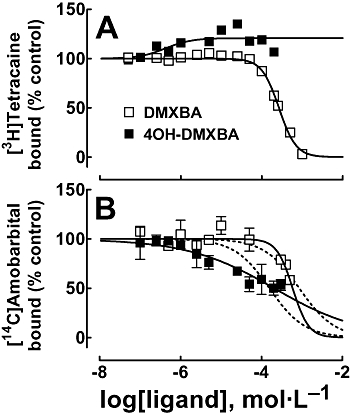Figure 5.

Effect of BAs on [3H]tetracaine (A) and [14C]amobarbital (B) binding to Torpedo nAChRs in the resting state. Inhibition of [3H]tetracaine (A) or [14C]amobarbital (B) binding to the resting nAChR elicited by DMXBA or 4OH-DMXBA respectively. nAChR-rich membranes (0.3 µmol·L−1 AChR) were equilibrated (2 h) with 6 nmol·L−1[3H]tetracaine or 13 µmol·L−1[14C]amobarbital, in the presence of 1 µmol·L−1α-BTx (nAChRs are mainly in the resting state), and increasing concentrations of the BA (e.g. 0.1–1000 µmol·L−1; depending on the experiment type). Non-specific binding was determined in the presence of 100 µmol·L−1 tetracaine or 400 µmol·L−1 amobarbital respectively. The apparent IC50 values for DMXBA and 4OH-DMXBA, the EC50 value for 4OH-DMXBA (A), and the respective nH values were obtained by non-linear least-squares fit according to eq. 1. In the case of (B), a variable (−) or constant (nH= 1) nH value (---) was considered for the sake of comparison. The IC50, EC50 and nH values are summarized in Table 2. Values shown are the result of one out of two experiments (A) or the mean ± SD from two experiments performed in triplicate (B). 4OH-DMXBA, 3-(4-hydroxy-2-methoxybenzylidene)-anabaseine; α-BTx, α-bungarotoxin; BA, 3-(benzylidene)-anabaseine; DMXBA (or GTS-21), 3-(2,4-dimethoxybenzylidene)-anabaseine; nAChR, nicotinic acetylcholine receptor; nH, Hill coefficient.
